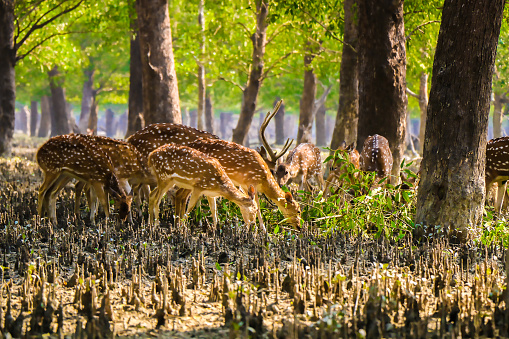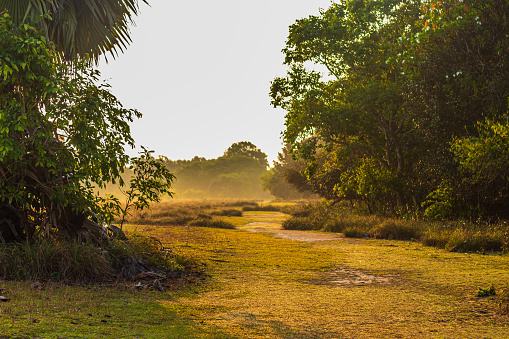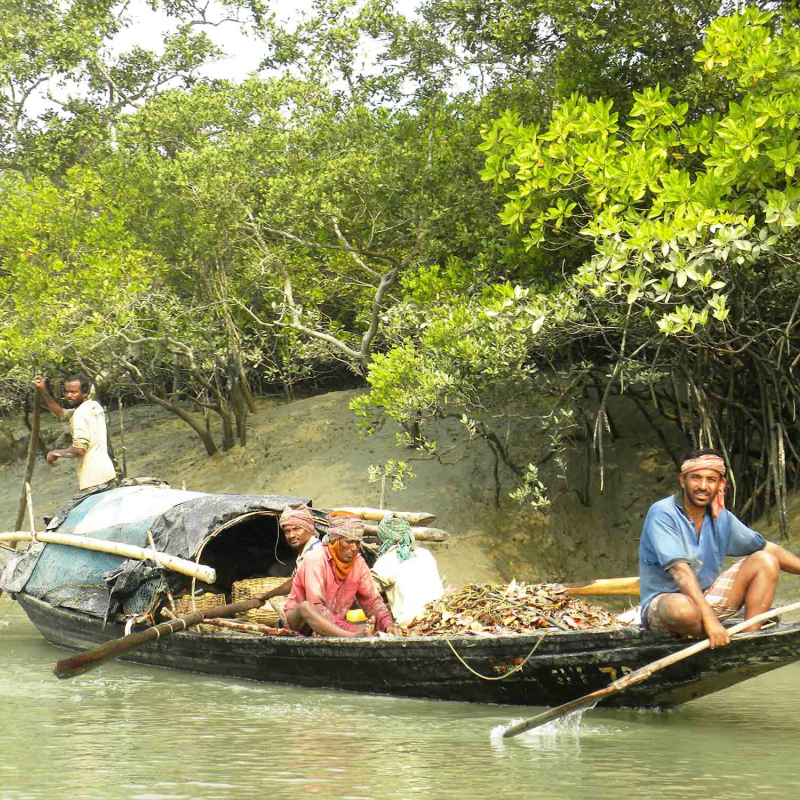Sundarban From The Perspective Of An Environmentalist: Sundarban is only a minor component of this vast ecosystem. But the job it accomplishes is enormous and admirable. It not only provides a large amount of oxygen, but it also supports wild creatures and helps to preserve the ecology. Is home to several incredible therapeutic plants. So, certainly, Sundarban serves a significant environmental interest. Sundarban 1 Night 2 Days Package from Kolkata is available. We can know more about Sundarban From The Perspective Of An Environmentalist.

Sundarbans is a section of the world’s biggest delta, created by the rivers Ganga, Brahmaputra, and Meghna. The region is a marsh bordered by the plains and the sea, with various river tributaries, creeks, and canals running through it. Although the geology renders the territory unsuitable for settlement, it is highly inhabited, with communities clustered along the forest’s margins. Its mangrove forest serves as a natural flood barrier, shielding the coastal people from the devastation caused by storms that strike the region (Vermaat and Thampanya 2006).

However, growing deforestation and damage to mangrove forests for the extraction of commodities with great economic value is not only leaving the beaches increasingly exposed and vulnerable to storms, but it is also reducing the region’s unique biodiversity. We can know more about Sundarban From The Perspective Of An Environmentalist.
Biodiversity of the Sundarbans
The Sundarbans is one of the world’s biggest mangrove forests, and it gets its name from the major mangrove species, Heritiera fomes, also known locally as the Sundari tree. Sundarbans, tare, is home to an extremely rich floral and faunal variety, and mangrove forests are biologically productive habitats. The region has 63 of the 69 mangrove species present in India, accounting for 10% of the country’s mangrove habitat (Danda et al. 2011). The Sundarbans’ algal flora has not been well studied, although a total of 150 species have been found in recent research on the Indian side of Sundarbans (Naskar et al. 2004).

Despite a fragmentary record of most faunal groups in the region, a total of 1,434 faunal species have been reported (Das and Nandi 1999). On the Indian side of the forest, there are 165 species of estuarine and coastal marine life, including hilsa (Tenualosa Elisha), spotted javelin fish (Pomadasys hasta), and others (Sanyal 1999).

There are also seven amphibian species and 59 reptile species present, including the king cobra (Ophiophagus hannah), Indian spectacled cobra (Naja naja), Indian python (Python molurus), olive ridley turtle (Lepidochelys olivacea), green turtle (Chelonia mydas), and others (Naskar et al. 2004). Waterfowl found in the area include several species of kingfisher, white-bellied sea-eagles, herons, egrets, storks, sandpipers, and others. Woodpeckers, barbets, shrikes, drongos, and other forest birds can also be seen in plenty.
The Sundarbans have one of the greatest populations of tiger (Panthera tigris), spotted deer (Cervus axis), and wild boar (Sus scrofa), all of which are abundant and serve as the tiger’s primary prey (Gopal and Chauhan 2006). We can know more about Sundarban From The Perspective Of An Environmentalist.
Sundarbans: History of the ecosystem
The Sundarbans mangrove forests have a long history of conservation and management, which is critical for understanding the region’s current conservation issues. In studies of the Sundarbans’ history, evidence of human infiltration in the form of proto-urban communities dating back to the Mauryan period has been emphasized (Pandit 2013). The Mauryan Empire, which ruled most of the Indian subcontinent during 321-226 BC, placed a premium on forest management, categorizing them depending on their intended purpose. The Sundarbans were also part of the empire’s forest area. However, during the Gupta Dynasty (AD 320-415), large expanses of land were removed and turned into agricultural land, and this management strategy was not maintained.

The story of land reclamation gets stronger in the pre-Mughal era, which can be traced back to before the Muslim-Indo-Turkish hegemony from AD 1204 to 1575. (Townsend 1987). During this historical period, the region was known to be populated by the Hindu Bengali castes of Pod in the west and Chandals in the east, who worked as fishermen.
However, it is believed that Muslim holy men who established the Islamic religion in parts of Bengal between the thirteenth and eighteenth centuries played a significant role in the thirteenth-century intensification of wet rice cultivation in Sundarbans, thus contributing to the alteration of the natural forest ecosystem (Eaton 1990).

There are stories of the region being abandoned owing to floods that caused the displacement of numerous communities in 1584. Depopulation is said to have continued in the years that followed, and the land was overtaken by woods. While some ascribe it to Portuguese and local pirate assaults, there are also stories of a shift in the river flow, which leads to increased salinity of agricultural land (Chakrabarti 2009). We can know more about Sundarban From The Perspective Of An Environmentalist.
- Biodiversity of the Sundarbans
- Sundarbans: History of the ecosystem
- Human habitation
- Fisherfolk (Jele)
- Woodcutters and firewood collectors (Bhawalis)
- Honey collectors (Moulay)
- Crab and shell collectors (Chuniri)
- Tiger prawn seed collector
- Human-animal conflict
- Climate change and Sundarbans
- Conservation challenges in the Sundarbans
- The protection strategy of Sundarbans has been critiqued as follows:
- Addressing concerns on conservation
- We’d like to look at Sundarban through the eyes of an environmentalist in this blog. Let’s get started.
- 1. Plants that serve mother Earth:
- 2. Animals that get their natural Habitat:
- 3. Rivers get no stop:
- 4. The sky is cleaner :
- 5. Birds can be heard:
- What do people ask?
- Q. Can I take up an environment survey in Sundarban?
- Q. Is it costly In Sundarban?
- Q. Should I go to Sundarban now?
- Come to Sundarban and experience the love.
In 1764, the East India Company ordered Commissioner William Dampier and Lieutenant Hodges to survey and establish the limits of the Sundarbans forest after gaining control. Hodges split the forest into 236 pieces, totalling about 1.7 million acres. This gave the British a view of areas of land that were not under the government’s lease, providing them with the full potential of the Sundarbans as a revenue-generating region. The region’s alluvial land in the river delta had considerable economic potential, prompting the corporation to transform the ‘wasteland'[i] into paddy land.

They began reclamation efforts by transforming woods into agricultural land with the assistance of Bengali zamindars, rewarding them via land tenures. While formerly only bhawalis (the Sundarbans woodcutter group) had the right to collect lumber from the forest without paying income to the government, forests were brought to the common pool resources, bringing in individuals from agricultural and fishing communities as well, in timber extraction.
These groups were made up of Hindu clans as well as Muslims (Danda 2007). The tribes that were brought in largely to recover the land lived in huge numbers on area prone to flooding and cyclones, adopting subsistence techniques of life that affected the ecosystem (O’Donnell and Wooden 2015).

The reclamation process lasted long into the nineteenth century until Sundarbans was designated a protected forest in 1878, limiting the exploitation of forest resources in specific regions. Meanwhile, the government continued to lease land for agriculture, ensuring an inflow of income. The government took advantage of the legal restriction on the indigenous’ ability to exploit resources to secure and enhance their supply of various types of wood. We can know more about Sundarban From The Perspective Of An Environmentalist.
Nonetheless, land reclamation became a hard endeavour in the nineteenth century, when local tigers, dubbed “man-eaters,” attacked vulnerable forest clearers. Work had to be stopped in certain locations, and if this was done for a lengthy period of time, the cleared ground would revert to being a forest (Bacon 1837). The government implemented a prize strategy to entice indigenous shikaris (hunters) to kill tigers. This resulted in the large-scale murder of tigers in Sundarbans between 1881 and 1912 when over 2,400 adult tigers were slaughtered in the region (Chakrabarti 2009).

Sundarbans, surprisingly, developed as an insurance provider against unexpected downturns in the following years. During the nineteenth-century Bengal famine, the region provided food grains to impoverished areas and housed numerous immigrants from central and eastern India (Mukherjee and Tiwari 1984).
Sir Daniel Hamilton, a Scottish merchant and visionary, built a utopian town in Sundarbans in 1903 that embraced people of all castes, creeds, and races. He founded a cooperative society and focused on rural upliftment through rehabilitation schemes. Rabindranath Tagore, Sir Hamilton’s close companion, is also reported to have visited the Sundarbans in 1932.
The 1943 famine and India’s independence from British control both contributed to agricultural intensification in the 1940s. Bengal was separated into two halves, West Bengal and East Bengal (present-day Bangladesh), with the Sundarban region, partitioned and 40 per cent of the forest remaining in West Bengal. During this time, people moved from East Bengal to the Indian side of the jungle and vice versa. After the zamindari system was abolished in the 1950s, the ryotwari system was implemented, in which land was now leased directly to peasants.
This fueled a renewed zeal for converting forests into agricultural land, causing the siltation of river islands and a severe reduction in fish populations.
The loss of forests and biodiversity that occurred during this era due to a concentration on agriculture eventually had a negative influence on biodiversity, which was noticed many years later with the extinction of species endemic to the Sundarbans (Mukherjee and Tiwari 1984).
Following the 1971 Bangladesh struggle for independence, the human population on the Indian side of the Sundarbans increased significantly, rising from 2 million in 1971 to 4.1 million in 1981. (Census 2001). This can be linked to an increase in the number of refugees from East Bengal settling in the Sundarbans’ populated villages, where their relatives and neighbours had relocated before independence.
The Sundarbans, home to a sizable tiger population, came under severe strain due to the loss of tiger habitat caused by human population growth. Sundarban Tiger Reserve was established by the Government of India in 1973 to conserve the habitat of the national animal.

Although this rekindled conservation efforts in the Sundarbans, it also sparked tension with refugees who planned to settle outside of the protected region. Authorities forcefully removed hundreds of refugees from the settlement of Marichjhanpi, one of the Sundarbans’ wooded islands, in 1978 for breaching the Forest Act (Jalais 2005). While this was an attempt to emphasize habitat protection, the decision was heavily criticized for pitting the already downtrodden against tigers, the national animal. We can know more about Sundarban From The Perspective Of An Environmentalist
Uncontrolled changes to the forest ecology, such as expanded forest area brought under human settlements and agricultural land, as well as the construction of embankments, resulted in multiple extirpations (local extinction) and habitat constriction for various species throughout time. Water buffalo (Bubalus bubalis), marsh deer (Cervus duvaucelli), Javan rhinoceros (Rhinoceros sondaicus), gharial (Gavialis gangeticus), and Chitra turtle (Chitra indica) are all reported to be extinct in the region (Danda et. al. 2011, Sanyal 1999).
The barking deer (Muntiacus muntjak) is also potentially extinct in the area, having been last seen in the 1970s (Sanyal 1999).

Degradation of the Sundarbans’ biodiversity, quality, and extent has driven the awareness that the forest is an exhaustible resource, resulting in conservation activities. Sundarbans is now designated as a National Park, Tiger Reserve, and Biosphere Reserve. UNESCO included it on the list of World Heritage Sites in 1985.
Human habitation
Sundarbans is the world’s biggest prograding delta, with a complex network of tidal rivers, mudflats, and tiny islands that are home to a salt-tolerant type of mangroves. Permanent occupancy is limited due to the region’s complicated physiography, with the forest comprising 70% of the territory. Only 54 of the 102 islands in the Indian section of the Sundarbans are now inhabited. We can know more about Sundarban From The Perspective Of An Environmentalist
These islands on the outskirts of the protected area include settlements with dwellings erected on elevated platforms supported by 3-5 meter high poles made of bamboo or forest wood. There are embankments erected around the islands to prevent erosion and keep salty water from accessing the inhabited area.

Embankments have been described as an important component of living on an island or in a deltaic environment, where islands are formed by silting of the intervening channels to provide an elevated platform that is permanently above high tide. However, during the British process of land reclamation in the Sundarbans, this process was accelerated and the land was reclaimed at the limit of low water level with the use of differentially constructed embankments. We can know more about Sundarban From The Perspective Of An Environmentalist
As a result, the silt that would have been deposited on the island boosted its height and was deposited in the creek, elevating the level of the creek bed higher than the low-lying reclaimed lands and transforming them into permanent marshes (Mukherjee 1969). We can know more about Sundarban From The Perspective Of An Environmentalist
New embankments were also constructed to prevent the area from developing into permanent wetlands. This is being questioned as a possible explanation of the enhanced habitability of Sundarbans’ low-lying land tracts. Whereas Bhattacharya (1998) asserts that “embankments blocked off the prospect of these tracts ever naturally developing into lands habitable by people,” Hunter (1875) states that “embankments sealed off the possibility of these tracts ever naturally maturing into lands hospitable by humans.”
In the Sundarbans, zamindars who leased property from the British used a land reclamation scheme in which they first embanked the land to keep saltwater out, then cleared the woods to make room for tanks for water supply and storage, as well as houses for the workers. Rice was planted right away to prevent reeds from taking over the area. The zamindars erected these embankments in an unprofessional manner, employing materials that were unsuited for the soil and needed continuous upkeep (Sarkar 2002; Bhattacharya 1999). We can know more about Sundarban From The Perspective Of An Environmentalist
Migrant labour was recruited in the neighbouring districts of Midnapur and central India to build embankments (Iqbal 2011). Several Santhal settlements sprang up on the outskirts of the swampy Sundarbans in the 1830s (Dasgupta 1984). These migrants are reflected in today’s population via their descendant generations. We can know more about Sundarban From The Perspective Of An Environmentalist.
After the zamindari system was abolished, the embankments became public property, and their upkeep was reduced due to a lack of a sufficient budget with the state government. The embankments were unstable and eventually collapsed due to natural forces, producing salty water incursions in the agricultural fields. Culturally, a segment of the populace saw agriculture as a respectable career, and the inability to produce their primary crop had a detrimental influence on the household. According to Danda (2007), 67 per cent of the households that embraced fishing and other water-based livelihood activities after the embankments collapsed were living in poorer conditions than before. We can know more about Sundarban From The Perspective Of An Environmentalist.
Surprisingly, there is a link between the rupture in the embankments and the increase in human strain on the environment. With the collapse of each embankment, pressure builds on the global common pool of resources, which in this case include forest resources and avifauna variety in streams, posing a direct threat of degradation (Danda 2007).
However, the vulnerability of the Sundarbans’ people is not just due to embankment breaches. A large number of landless labourers, frequent seasonal changes, climatic occurrences resulting in agricultural failure, significant human-animal conflict, and other concerns contribute to further marginalizing the population (Debnath 2013).

Sundarbans is a critically undeveloped region with limited infrastructure, communication and transportation networks, and healthcare services (Chowdhury et al. 2008). As a result, 32 per cent of the 4.1 million (based on the 2001 census performed by the Government of India) people living in Sundarbans are directly or indirectly dependent on forest resources. They are large groups who have historically practised the following primary forest-based livelihoods: We can know more about Sundarban From The Perspective Of An Environmentalist
Fisherfolk (Jele)
People living outside of the protected forest region fish in the creeks and rivers, while communities living near the shore fish in the sea. Fishermen, known locally as jelly, are known to employ both conventional and motorized boats for fishing. Fishing in the Sundarbans has its own set of occupational dangers, including as encounters with animals and adverse weather (Chowdhury et al. 2008).

Woodcutters and firewood collectors (Bhawalis)
Officially, around 5% of the population is involved in the collecting of wood. A Boulay normally leads a crew of 6-10 woodcutters into the forest. A Boulay is a guy with traditional knowledge from the society known as bhawalis. The community has the knowledge to keep the crew safe in the wild. The local populace thinks that bhawalis have mystical abilities that they employ to defend the work area by preventing tigers from entering their charmed zone.

Honey collectors (Moulay)
Because honey gathering takes occur in tiger habitat, it is considered extremely risky. This seasonal activity employs around 3% of the population and yields 200 quintals of honey and 1000 kg of wax each year (Vidal 2008). This is also a group activity in which a team of 8 to 10 people is guided by a Moulay who is an expert in navigating impenetrable woodlands as well as traditional beehive cutting and honey harvesting procedures. Locals think that the Moulay community, like the bhawalis, has mystical powers to avoid tiger assaults on the group through rituals and chanting.

Crab and shell collectors (Chuniri)
The villagers gather estuarine mud crabs and molluscs that are found on the forest floor and in the mud. The group of shell collectors is also known as chuniri because the shells are used to make lime, shrimp, and poultry feed. However, because crab and shell collecting takes place in swampy locations, collectors are sometimes assaulted by tigers and crocodiles.

Tiger prawn seed collector
It is a highly profitable business mostly performed by women and children known locally as meen-Dhara (juvenile-prawn catchers) who harvest prawn seeds from brackish water. According to data from the Government of West Bengal (2008), 1300-1500 million prawn seeds are gathered annually, fueling demand from the nearby shrimp farming sector. This also allows collectors to earn INR 50-100 per day per individual on the spot. However, because the collectors must be waist-deep in water, they are vulnerable to sharks (Indian dog shark, Scoliodon laticaudus, locally known as camote) and crocodile attacks.

Human-animal conflict
While these activities provide a source of revenue for the residents of the Sundarbans, the lack of suitable infrastructure prevents excellent returns from the crop. With few options available, residents in the region turn to unsustainable methods of extracting forest products to augment their little income. This also increases the amount of time spent in the forest or waterways, putting them in a higher danger of being victims of human-animal conflicts. Tiger attacks are widespread in the Sundarbans, with over 40 people killed each year.
It is believed that 67.2 per cent of all tiger attacks happened as a result of unlawful forest entrance (Chowdhury et al. 2008). The majority of the casualties were landless impoverished men who died prematurely, leaving behind widows who were driven into poverty. According to Bhattacharya (2012) in her essay ‘The Tiger Widows of Sundarbans,’ there are around 3,000 tiger widows now surviving in Sundarban.
Climate change and Sundarbans
Aside from the human-animal conflict experienced by the region’s people who rely on forest resources for a living, the territory is also threatened by another reality: climate change. Because the Sundarbans is a low-lying region prone to cyclones, climate change has a substantial influence on the region’s flora, wildlife, and inhabitants.
Over a 37-year period, the surface water temperature in Sundarbans has climbed at a pace of 0.5o C faster than the worldwide increase in surface water temperature, which stands at 0.06o C every decade (Ghosh 2012). This has not only had a negative influence on avifauna life, but it is also proving to be harmful to the health of the mangrove environment, which is now rebuilding at a considerably slower rate. We can know more about Sundarban From The Perspective Of An Environmentalist
Between 1951 and 2010, the Sundarbans experienced a rise in the severity of cyclonic cyclones. Property damage and agricultural failure have made the populace impoverished, causing considerable migration from the region to adjacent cities. Low agricultural yields as a result of irregular rainfall have also contributed to the aforementioned.
While human intervention, such as deforestation, has contributed to forest degradation and increased human-animal conflict in recent years, pollution, toxic silt, and untreated domestic and industrial effluents carried by rivers downstream have limited fresh water supply, causing a further loss in the region’s biodiversity (Danda et. al 2011). The region also creates a significant quantity of garbage domestically, which adds to the load in the absence of effective recycling methods.
Conservation challenges in the Sundarbans
The Sundarbans is a vulnerable environment with one of the longest stretches of mangrove forests in the world, and it must be maintained since it supplies a range of ecosystem services. On the other side, there is the influence of human activity in the region, which is dependent on the population’s climate-change-induced adaptation issues in the lack of necessary development efforts, social fairness, and governance systems. We can know more about Sundarban From The Perspective Of An Environmentalist.
Despite various regulations and policies enacted to safeguard the mangrove forest, encroachment on the protected area for agriculture and resource exploitation continues, exacerbating the pressure on the ecology. We can know more about Sundarban From The Perspective Of An Environmentalist
Natural scientists and economists have been raising concerns about the lack of planning that has hurt the region and has brought the ecosystem to the threshold of its carrying capacity. The lack of planning has been attributed to the region’s administration which is handled by multiple agencies which were set up to support the implementation of national and international conservation initiatives attached to the Sundarbans.
The protection strategy of Sundarbans has been critiqued as follows:
…it should be mentioned that the Central Government has classified the whole Sundarbans (including wooded and populated regions) as a biosphere reserve. However, although areas designated as protected forests for tiger conservation and coastal zone protection are managed directly by the Central Government, populated areas are governed by the State Government. This leads to communication breakdowns, lost time and resources, and task duplication between the Central and State troops. We can know more about Sundarban From The Perspective Of An Environmentalist.
Furthermore, the lack of a conservation master plan for the region, despite the presence of two planning agencies, the Sundarban Development Authority and the Sundarban Development Board, both of which have been operational for the past 25 years, has drawn criticism from development workers in the region. We can know more about Sundarban From The Perspective Of An Environmentalist
Addressing concerns on conservation
While ecosystems and biodiversity are maintained, it is critical that the governance structure be adjusted to enhance the natural resource base legally accessible to the community, assisting them in increasing their revenue generation ability and decreasing their reliance on the conserved region. This would need significant planning that takes into account the problems in all areas of development and socioeconomic pressures, as well as the effects of climate change on the forest and people’s livelihoods. The planning approach will need to involve coordinated measures to limit population expansion in the region. To alleviate the rising pressure on the ecosystem, policies aimed at universal education, gender equality, and women’s empowerment will need to be enhanced.
Internalization of a development plan with significant components on land management, sustainability of natural resource base, disaster management, and livelihood management in the context of climate change is required to solve the region’s conservation problems. A significant emphasis must be focused on moving and rehabilitating the population residing in severely susceptible sections of the islands, which have been identified by a zone-by-zone vulnerability assessment of the region. We can know more about Sundarban From The Perspective Of An Environmentalist
Given the importance of embankments in people’s lives, the government will need to take steps to rebuild embankments based on innovative designs that are in sync with land and soil conditions, utilizing raw materials that can endure high-intensity weather events. Furthermore, measures to expand already existing capacity development projects to lessen reliance on land and forest, in conjunction with civil society organizations and regional stakeholders, might aid in the internalization of alternative livelihood choices. We can know more about Sundarban From The Perspective Of An Environmentalist. We can know more about Sundarban From The Perspective Of An Environmentalist.
Given the aesthetic value of the location, community-based tourism can be fostered as an alternative source of income. While this may be a beneficial move for the community in terms of nourishment, it is critical that both the administration and the community take equal responsibility for limiting the impact of this program on the forest. Building the people’s ability for this would need a fresh effort in education on the relationship between population, environment, and development in order to instil the concept of environmentally sustainable development as opposed to solely economic growth. We can know more about Sundarban From The Perspective Of An Environmentalist.
The interventions for poverty reduction and development, which are largely aimed at strengthening the adaptive ability of the poor, suffer the weight of unfavourable climatic conditions, which make these interventions expensive, necessitating additional expenditures across sectors. According to World Bank estimates, the area has received 38 billion dollars in disaster relief and recovery loans and grants over the previous two decades. This demands a discussion about “adaptation debt,” which places the burden of compensating for the harm done to developing countries on wealthy countries.
Furthermore, a higher level of organizational transboundary collaboration is desired to enable the successful protection and regeneration of the mangrove ecosystem. In this instance, both the Indian and Bangladeshi governments will require an integrated strategy for human well-being and environmental sustainability in the Sundarbans.
We’d like to look at Sundarban through the eyes of an environmentalist in this blog. Let’s get started.
1. Plants that serve mother Earth:
Plants are an essential component of mother earth. If you are able to live freely and peacefully on Earth, it is entirely due to the efforts of those plants. Plants make our lives on Earth better and easier.
2. Animals that get their natural Habitat:
Sundarban Animals can live in a completely natural environment. There is no one to bother or terrify them. In Sundarban, they may walk about freely and cheerfully. They take pride in their natural surroundings.
3. Rivers get no stop:
The rivers here never cease flowing. They move in the correct order and shape. There is no manual stop or interruption. This is how the river flows, allowing all aquatic species to live happily ever after.
4. The sky is cleaner :
The sky is clear and the air is pure here. There is no pollution anywhere. This makes the sky clean and blue. This also makes the birds who soar across the skies happy. They can breathe fresh air and live a healthy lifestyle.
5. Birds can be heard:
Every dawn and afternoon, you may hear the lovely chittering of birds. They wander about pleasantly and seem to like being here. This is their home and environment.

What do people ask?
Q. Can I take up an environment survey in Sundarban?
A: You may do an environmental survey in Sundarban. It will be an unforgettable experience for you.
Q. Is it costly In Sundarban?
A: No, Sundarban is not that expensive. It is, nevertheless, less expensive and of higher quality.
Q. Should I go to Sundarban now?
A: Yes, you may now travel to Sundarban with an incredible desire to study.
Come to Sundarban and experience the love.
You must visit Sundarban to experience the quantity of love it radiates throughout your life. Book a Sundarbans trip in West Bengal. This will truly benefit you.
Visit Sundarban and feel happier.
We have Sundarban Tour Packages every day
For Booking Of Best Sundarban Package( Starting from 2799/-)
Name: Dilip MAity
Organization: Royal Sundarban Tourism
Organisations Web link: https://royalsundarbantourism.com/
Contact: +917439965413 / 8584838109
Gpay / Phone pay : 9804049535
Email: info@royalsundarbantourism.comAddress: Tiger More, Gosaba, Pakhiralay, Pakhiralay Main road, District- 24 Parganas South, West Bengal 743370

